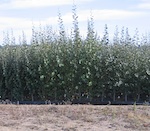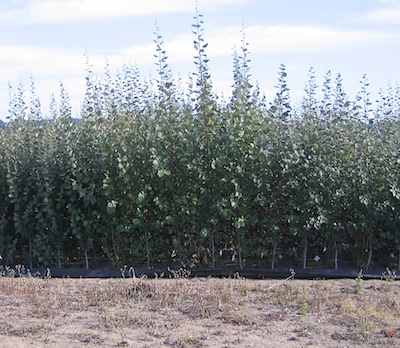
Reduced height trees could benefit biomass production
September 28, 2012
By Oregon State University
 September 28, 2012, Corvallis OR – The same “green revolution” concepts that have revolutionized crop agriculture and helped to feed billions of people around the world may now offer similar potential in forestry, scientists say, with benefits for wood, biomass production, drought stress and even greenhouse gas mitigation.
September 28, 2012, Corvallis OR – The same “green revolution” concepts that have revolutionized crop agriculture and helped to feed billions of people around the world may now offer similar potential in forestry, scientists say, with benefits for wood, biomass production, drought stress and even greenhouse gas mitigation.
Researchers at Oregon State University recently outlined the latest findings on reduced height growth in trees through genetic modification, and concluded that several advantageous growth traits could be achieved for short-rotation forestry, bioenergy, or more efficient water use in a drier, future climate.
This approach runs contrary to conventional wisdom and centuries of tree breeding, which tried to produce forest trees that grow larger and taller, the researchers note. But just as the green revolution in agriculture helped crops such as wheat and rice produce more food on smaller, sturdier plants, the opportunities in forestry could be significant.
“Research now makes it clear that genetic modification of height growth is achievable,” said Steven Strauss, an OSU professor of forest genetics. “We understand the genes and hormones that control growth not only in crop plants, but also in trees. They are largely the same.”
In a study published in Plant Physiology, researchers inserted a number of genes into poplar trees, a species often used for genetic experiments, and valuable for wood, environmental and energy purposes. They described 29 genetic traits that were affected, including growth rate, biomass production, branching, water-use efficiency, and root structure. All of the changes were from modified gibberellins, plant hormones that influence several aspects of growth and development.
The range and variation in genetic modification can be accurately observed and selected for, based on hormone and gene expression levels, to allow production of trees of almost any height.
For example, for ornamental purposes it would be possible to grow a miniature poplar, or even a Douglas-fir, as a potted plant.
And because height growth, in competition for sunlight, is a primary mechanism that trees use to compete for survival, there would be reduced concern about use of such genetically modified trees in a natural environment. On a long-term basis they would be unable to compete, shaded by larger trees and ultimately they would die out.
Scientists could also produce trees that might have a larger root mass, which should make them more drought-resistant, increase water use efficiency, increase elimination of soil toxins and better sequester carbon. This could be useful for greenhouse gas mitigation, bioremediation or erosion control.
 |
|
| Researchers have found that genetic modification of height growth is achievable. (Photo: OSU) |
Smaller trees could also be selected that have sturdier trunks for some uses in short-rotation plantation forestry, significantly reducing the number of trees blown down by wind. And shorter, thicker and straighter trunks might create higher-value wood products in many tree species, Strauss said.
Some semi-dwarf trees produced by conventional tree breeding techniques are already an important part of the horticulture industry, allowing easier harvesting of fruit and higher yields. Genetic modification could add new characteristics and more scientific precision to the process, researchers said.
“The main limitation is the onerous regulatory structure for genetically-modified plants in the United States,” Strauss said. “Even short, safe and beneficial trees are unlikely to be able to bear the high costs and red tape inherent to obtaining regulatory approval.”
This research has been supported by the U.S. Department of Energy, U.S. Department of Agriculture, National Science Foundation, and industry members of the Tree Biosafety and Genomics Research Cooperative at OSU.
Click here to read the published study.
Print this page